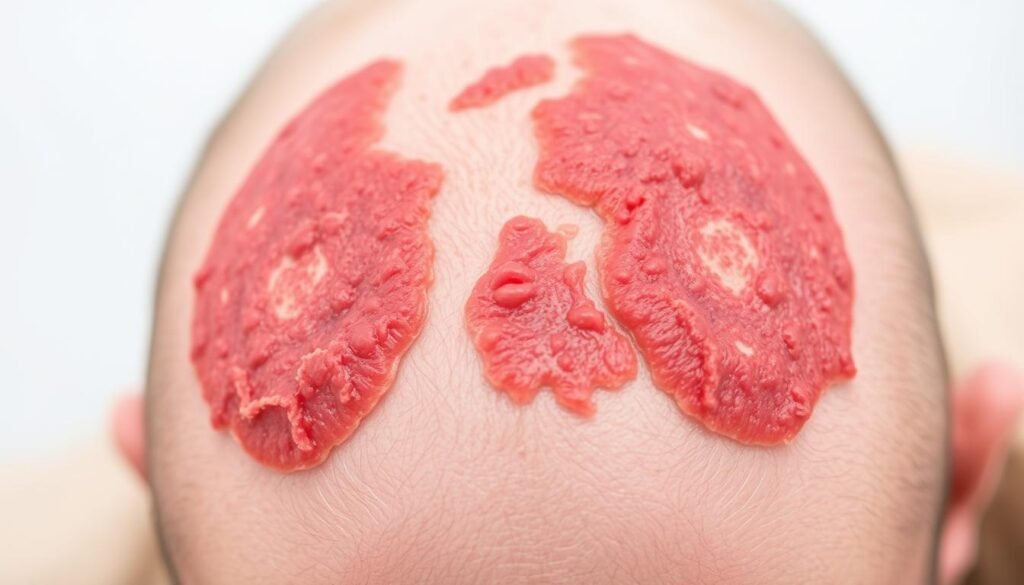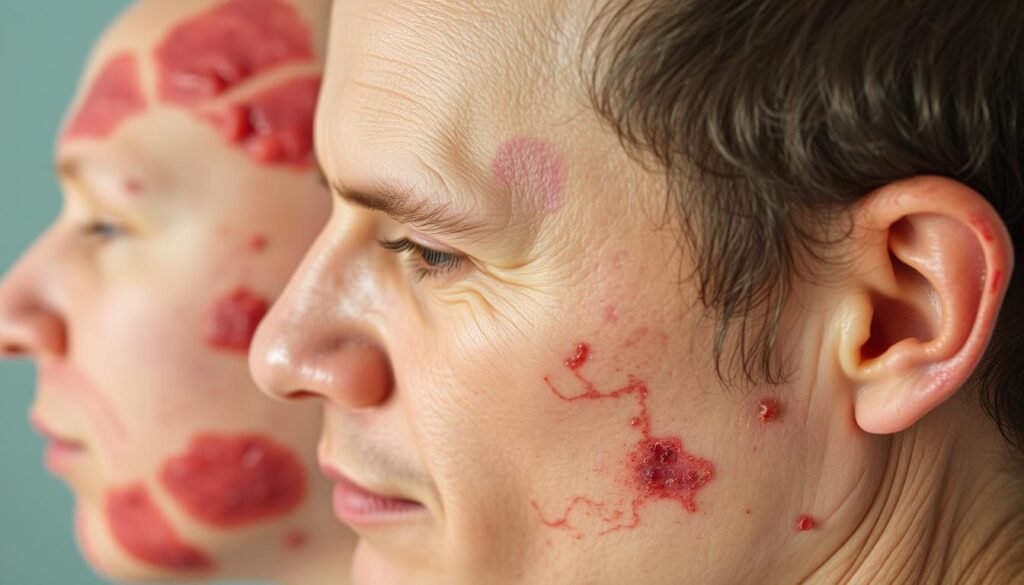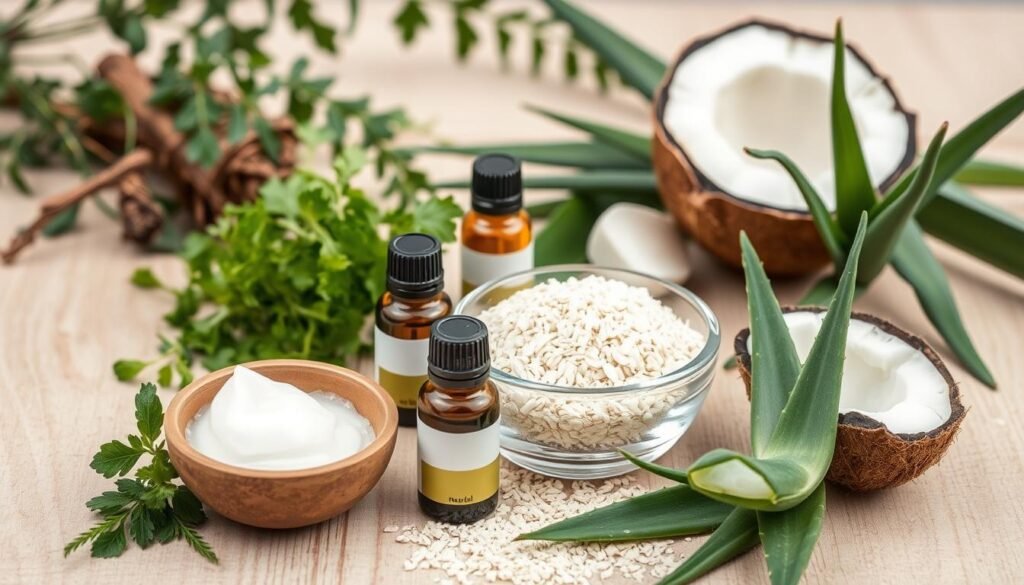Did you know about 50% of adults around the world face dandruff sometime? Though many see it as a small beauty problem, it’s often caused by Malassezia yeast growing too much. This yeast lives on our skin normally. But when it grows a lot, it can cause different skin issues. This is especially true for people dealing with stress. We will explore how stress and Malassezia overgrowth are linked. This connection can lead to different fungal infections and skin problems. By understanding this link, people can better manage their skin health and find good treatments.
Key Takeaways
- Stress greatly affects the growth of Malassezia, which can cause various skin problems.
- About half of all adults worldwide get dandruff, a key sign of Malassezia’s too much growth.
- Generally, men get dandruff more often than women.
- Knowing how stress plays a role can help find the causes of fungal infections.
- To better manage skin health, making some lifestyle changes and using specific treatments is helpful.
- Spotting symptoms early can improve how well Malassezia-related conditions are handled.
Understanding Malassezia: The Yeast Behind Skin Conditions
Malassezia is a type of fungus that lives on our skin. It includes 14 different species. While it usually doesn’t cause problems, it can lead to skin issues if its levels get out of balance.
These fungi love oily areas because they eat the fatty acids in sebum. They are linked to conditions like seborrheic dermatitis and pityrosporum folliculitis. For babies, especially within their first three months, about 42% can develop cradle cap.
Certain people, especially men and those assigned male at birth, might get yeast infections more due to oilier skin. Both adults and teens can experience dandruff. This is a common skin issue for many ages.
Pets, particularly dogs, can also be affected by Malassezia. Breeds like the West Highland White Terrier and Poodle might get yeast infections more often. Treating these involves antifungal meds and good hygiene. It’s important to keep an eye on the condition.
Knowing which Malassezia species is causing the problem is key to treatment. Different species react differently to antifungals. A personalized plan is often needed, focusing on the specific causes and treatments.
For extra details on Malassezia and how it impacts skin, check this link on malassezia dermatitis.
What is Malassezia Overgrowth?
Malassezia overgrowth happens when a yeast on our skin grows too much. This imbalance can lead to skin infections. Malassezia lives on our skin, especially where it’s oily like the scalp and face. Usually, it’s harmless and lives alongside other microbes.
Things like hot weather, high humidity, and a weak immune system can cause it to grow out of control. This yeast has over 18 types, and some are linked to skin problems. Group A, for instance, is often studied for its role in skin diseases.
When Malassezia grows too much, it can cause issues like fungal acne and dandruff. Fungal acne appears as small, pink bumps and is different from regular acne. It’s crucial to understand Malassezia to treat it properly.
Stress and Malassezia Overgrowth: The Connection
Let’s look into how stress and Malassezia overgrowth affect our skin. When we’re stressed, our immune system can’t fight skin infections well, including those from Malassezia. High stress increases cortisol, causing a hormonal imbalance. This makes it easier for Malassezia to grow.
How Stress Affects the Immune System
Stress weakens our immune system, making it hard to fight infections. When stressed, our bodies make more cortisol. This reduces the power of immune cells. As a result, Malassezia grows, leading to skin issues like redness and flaking. Stress can make dandruff worse and cause flare-ups.
The Role of Hormonal Imbalance
Stress-related hormonal imbalances affect our skin. These imbalances cause more oil production, feeding Malassezia. This can lead to seborrheic dermatitis, especially during stressful times or puberty. Managing stress well can help avoid skin issues linked to Malassezia overgrowth.
Common Skin Conditions Associated with Malassezia
Malassezia yeasts play a big part in skin issues. They can lead to conditions like seborrheic dermatitis and pityrosporum folliculitis. They are also a big reason behind dandruff.
Seborrheic Dermatitis Explained
Seborrheic dermatitis shows up as greasy, yellowish scales, mostly on your scalp and face. It happens when there’s too much Malassezia yeast. This can get worse with stress or hormone changes.
Itching and inflammation are common, making life tough for those affected. A shampoo with 5% Solanum chrysotrichum can help. Omega-3s might also lessen inflammation. Studies show treating seborrheic dermatitis needs a well-rounded approach.
Understanding Pityrosporum Folliculitis
Pityrosporum Folliculitis appears as itchy, pus-filled bumps. It’s caused by Malassezia infecting hair follicles. It often looks a lot like acne, which can lead to the wrong diagnosis.
Topical antifungals or oral meds can manage it well. Knowing Malassezia’s role helps doctors find the right treatment.
The Relationship Between Dandruff and Malassezia Overgrowth
Dandruff is both common and annoying. It’s mostly because of Malassezia. This yeast causes inflammation and itching, which make dandruff worse.
Antidandruff shampoos help keep the yeast in check. This is key for getting rid of dandruff.

| Skin Condition | Symptoms | Treatment Options |
|---|---|---|
| Seborrheic Dermatitis | Greasy scales, itching, inflammation | Topical antifungals, omega-3 supplements |
| Pityrosporum Folliculitis | Itchy, pus-filled bumps | Topical or oral antifungals |
| Dandruff | Flaking, itching of the scalp | Antidandruff shampoos |
Factors Contributing to Malassezia Overgrowth
To manage and avoid skin problems, it helps to know what causes Malassezia to grow. Stress and what you eat are big factors. These can make it easier for this yeast to thrive.
Impact of Stress and Anxiety
Stress affects your health and can upset your immune system. If you’re stressed or anxious, your body makes hormones that help yeast grow. This is even more true for people prone to skin issues.
If stress goes on for a while, it can make things worse for those with skin conditions like seborrheic dermatitis. It’s important to manage stress well.
The Role of Diet and Nutrition
What you eat is key to your skin’s health and stopping Malassezia from growing too much. Eating too much sugar and refined carbs can help yeast grow. These foods mess up the balance of good and bad microbes on your skin.
Not getting enough nutrients can also weaken your immune system. This makes it harder to fight off infections, including those from yeast. Eating well and getting the right nutrients can help prevent Malassezia problems.
Symptoms of Malassezia Overgrowth
Mild to severe itching, flaking skin, redness, and pustules can show if Malassezia overgrows. These signs usually appear on the scalp, face, and upper trunk. Such discomfort can sometimes lead to more serious issues like infections. Spotting these symptoms early is key to managing fungal infections well.
M. globosa is linked to conditions like pityriasis versicolor, seen mostly in young adults from 20 to 40. Its spread grows in warm weather, making sweat a factor. This fact means one should watch their skin more closely in summer. Another condition, seborrheic dermatitis, affects about 3-5% of people. It gets worse with more oil from skin glands and stress.
Early detection of symptoms can lead to better control of skin conditions. The range of issues Malassezia can cause varies widely. So, if you’re worried about your skin, talk to a health professional. To learn more about Malassezia overgrowth, check out this publication.

Diagnosis and Treatment for Malassezia-Related Conditions
The journey to manage Malassezia-related conditions starts with an accurate diagnosis and the right treatment. It’s vital to know the symptoms and use diagnostic methods to detect this yeast. After finding it, doctors suggest treatments like antifungal medicines to lessen symptoms and prevent more issues.
Common Diagnostic Methods
Doctors start with a detailed check-up to diagnose. They use methods like:
- Skin Scrapings: A sample from the skin is checked under a microscope to find Malassezia yeast.
- Cultures: Fungal cultures help confirm the yeast species.
- Clinical Observation: Seeing the symptoms, especially with seborrheic dermatitis, aids in diagnosing.
Treatment Options for Fungal Infections
After diagnosis, the goal is to reduce Malassezia yeast and treat symptoms. Doctors might suggest:
- Medicated Shampoos: Special shampoos are available over the counter to deal with scalp issues.
- Topical Treatments: Creams with ketoconazole or ciclopirox help with skin infections.
- Oral Antifungal Medications: For tough cases, pills like itraconazole or fluconazole are used.
Topical and Systemic Antifungal Medications
Antifungal drugs are key in fighting Malassezia skin issues. Let’s explore how topical and systemic treatments work:
| Type | Examples | Application |
|---|---|---|
| Topical | Ketoconazole, Ciclopirox | Applied directly to affected skin or scalp |
| Systemic | Itraconazole, Fluconazole | Orally administered for severe cases |
Natural Remedies for Managing Malassezia Overgrowth
People facing Malassezia overgrowth often look for natural fixes. This can bring relief and balance back to their skin. Making changes to what you eat and using herbal solutions has a big effect on skin symptoms and health.
Dietary Changes and Elimination Diets
Starting an elimination diet can help control Malassezia overgrowth. Cutting out sugar and yeast from your diet helps tame the fungus on your skin. Eating lots of fruits and veggies may also reduce skin issues like seborrheic dermatitis.
Herbal and Homeopathic Remedies
Herbal treatments are key in fighting fungal infections. Ingredients like tea tree oil, garlic, and coconut oil are known for fighting fungus. They help ease symptoms linked to Malassezia. For more on these treatments, check out natural remedies for managing fungal acne. Using these herbal solutions can make skin healthier and more balanced.

Stress Management Techniques for Healthy Skin
Managing stress well is key to keeping skin healthy. Mindfulness and physical activity are great for easing stress. Over time, stress can cause skin problems like acne and seborrheic dermatitis. A holistic approach improves skin health and looks.
Mindfulness and Relaxation Techniques
Mindfulness and yoga lower cortisol, fighting stress-related skin issues. They bring relaxation and better emotional health. Being mindful helps you stay positive, which is good for your skin. For details on stress, dandruff, and skin, check out this resource.
Physical Activity and Its Benefits
Daily exercise boosts your mood and lowers stress. It improves circulation and endorphin levels, enhancing health. Regular exercise fights stress, helping your skin stay young and healthy. It also prevents hair loss.
| Technique | Description | Benefits for Skin |
|---|---|---|
| Mindfulness Meditation | A practice focusing on being present to reduce anxiety. | Lower cortisol levels, reduce acne flare-ups. |
| Yoga | Combines physical postures and breathing for mind-body connection. | Improves circulation, promotes relaxation. |
| Regular Exercise | Engaging in physical activity for overall health. | Enhances mood, reduces stress effects on skin. |
Prevention Strategies for Malassezia Overgrowth
Stopping Malassezia overgrowth needs smart steps focused on good immune health and skin care. Adding specific habits to daily life can greatly cut down skin issues caused by this fungus.
Maintaining a Balanced Immune System
Keeping your immune system strong is key to managing Malassezia on your skin. You can boost your immune health with these habits:
- Healthy diet: Eat lots of fruits, veggies, and grains that are packed with nutrients.
- Regular exercise: Stay active to help your immune system and lower stress.
- Adequate sleep: Make sure to get enough rest for your body to heal and keep strong.
- Probiotics: Have fermented foods like yogurt and kefir to improve your gut health.
Good Skincare Practices
Good skincare is critical for keeping Malassezia in check. Here’s what works:
- Choose suitable products: Look for skincare that is non-greasy, won’t clog pores, and fights fungus.
- Maintain hygiene: Wash your skin and hair with antifungal shampoo, especially after you get sweaty.
- Wear breathable clothing: Wear clothes that let your skin breathe, especially when it’s hot or humid. This helps keep you dry.
- Incorporate antifungal agents: Think about using products with tea tree oil, ketoconazole, or zinc pyrithione.
Using these prevention tips can really help your skin stay healthy. A good mix of immune support and careful skincare is the best plan to avoid problems caused by Malassezia overgrowth.
Conclusion
For healthy skin, understanding factors like Malassezia and stress is crucial. Stress deeply affects skin health. Knowing this can help us tackle skin issues head-on.
Managing stress well can prevent Malassezia overgrowth. Combined with good skincare, it strengthens the skin. This strategy links mind and body health for fighting skin problems.
Using a mix of stress relief and skincare works wonders. It’s key to improving your skin. Adequate rest, good food, and skincare are vital.
This article shows the need for a rounded skin care approach. By grasping Malassezia’s complexity and its stress links, you can keep your skin glowing and clear.